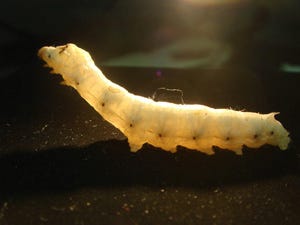October 4, 2010
|
Silkworms have been genetically modified to produce silk resembling that of spider silk. (Photo courtesy of ND Newswire) |
Scientists have been hard at work attempting to marshal the power of spider silk for a range of medical applications--including wound-care applications; suture materials; and muscle, bone, cartilage, tendon, and ligament repair scaffolds. It makes sense: Spider silk possesses mechanical attributes such as very high tensile strength and elasticity, making it one of the toughest fibers known to man. The problem is that spiders don't produce enough silk to render it marketable for mass human use.
Now, however, a team of researchers at the University of Notre Dame (Notre Dame, IN) the University of Wyoming (Laramie), and Kraig Biocraft Laboratories Inc. (Lansing, MI) has succeeded in producing transgenic silkworms. The advantage of these little animals is that they can spin artificial spider silk with strength and flexibility attributes similar to those of native spider silk.
Until this breakthrough, only very small quantities of artificial spider silk had been produced in laboratories. Kraig Biocraft believed these limitations could be overcome by using recombinant DNA to develop a biotechnological approach to producing silk fibers with a broad range of physical properties or with predetermined properties optimized for specific biomedical or other applications. To put its theories into practice, the company entered into a research agreement with Malcolm J. Fraser Jr., a Notre Dame professor of biological sciences who discovered and patented a genetic engineering tool called PiggyBac, a piece of DNA known as a transposon that can insert itself into the genetic machinery of a cell.
|
Transgenic silk features strength and flexibility properties similar to those of spider silk. (Photo courtesy of ND Newswire) |
With the assistance of Randy Lewis, a University of Wyoming biochemist and an authority on spider silk, and Don Jarvis, a molecular geneticist who specializes in insect protein production, Fraser genetically engineered silkworms incorporating DNA taken from spiders. When these transgenic silkworms spin their cocoons, the silk they produce combines both silkworm and spider silk and displays elasticity and strength approaching that of native spider silk. Since silkworms have long been cultivated to produce silk for commercial purposes, the scientists hope that these genetically engineered creatures can be used for large-scale production of engineered protein fibers with the physical properties required for medical device applications.
"This research represents a significant breakthrough in the development of superior silk fibers for both medical and nonmedical applications," Fraser remarks. "The generation of silk fibers having the properties of spider silks has been one of the important goals in materials science."
For more information on research into spider silk for medical device applications, see the Medical Product Manufacturing News articles "Spider Webs May Mimic Muscles and Serve as Future Medical Device Material," "Buzz Grows Around Insect-Inspired Silk," "Mimicking Mother Nature," and "Scientists Engineer Artificial Silk Using Bacteria."
About the Author(s)
You May Also Like




